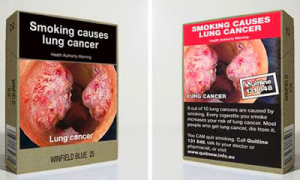
Georgetown University Medical Center researchers found that viewing graphic anti-smoking warning labels on cigarette packages stimulates activity in brain areas linked to emotion, decision-making and memory in a study published Feb. 16.
The investigation marks the first of its kind to be conducted in young adult smokers. Researchers conducted the study by showing the 19 participants, aged between 18 and 30 years old, 64 images of cigarette pack labels for four seconds each. Labels ranged from providing no warning of tobacco-use health risks to containing explicit images of potential long-term effects, such as tumors and rotting in the mouth.
The researchers then asked participants to rate to what degree each image motivated them to quit smoking on a scale of one to four. Participants were also connected to frontal magnetic resonance imaging scanners so researchers could monitor brain activity.
The study found that participants were much more likely to report a motivation to quit after viewing the more graphic images. It also showed noticeable brain activity in the areas responsible for making decisions, such as the amygdala and the medial prefrontal region.
GUMC assistant professor of oncology and co-lead author Darren Mays said the study aimed to analyze young smokers and methods of helping them overcome tobacco addiction.
“The goal of the study was to help us better understand how graphic warning labels on cigarettes may motivate young smokers to quit, and to ultimately contribute to the weight of evidence being considered surrounding [Food and Drug Administration] policy,” Mays wrote in an email to The Hoya. “Although it’s unlikely that any single study can tip this balance, our study adds uniquely to this evidence base by applying neuroimaging to show how graphic warnings may affect young smokers’ behaviors, which is new evidence that may contribute to ongoing policy considerations.”
The study’s other co-lead author and psychology professor Adam Green said this investigation has roots in traditional tobacco marketing, although the research team was looking to elicit negative reactions to smoking rather than positive ones.
“Using brain imaging in this way is actually something that marketers have been doing for a while now,” Green wrote in an email to The Hoya. “Their goal has been to find advertisements that elicit the kind of reactions in the brain that affect people’s decisions about what to buy, especially in emotion-related brain regions.”
Green said he is optimistic about the possibility of using marketing techniques in attempts to convince younger smokers to quit.
“One of the exciting things about this study is that we are using that approach in service of public health. Rather than trying to get people to buy things, the goal was to show how a graphic warning label — a kind of anti-advertisement — can elicit brain responses that are likely to influence decisions about smoking,” Green wrote. “Obviously, the long term goal is to shift people’s decision-making away from buying and smoking cigarettes.”
Qualifications for the study included age and smoking status, which Mays said were kept deliberately broad in order to gain a more inclusive look at the population of young adult smokers.
“Our research focused on this group because evidence indicates their vulnerable transitions from experimentation or ‘social’ smoking to regular, addicted smoking,” Mays wrote. “Participants were also screened for fMRI safety requirements, but otherwise we left the criteria fairly broad in order to capture a sample that reflects the young adult population of our local area.”
GUMC’s Lombardi Comprehensive Cancer Center Director Louis M. Weiner said he hopes this research will be influential for tobacco regulators at organizations such as the FDA and the National Institute of Health.
“The study provides important guidance to policy regulators who wish to assure that young people receive messages about the dangers of smoking that are emotionally impactful and favorably influence their decisions to either quit or not start smoking in the first place,” Weiner wrote in an email to The Hoya. “Such information would be very useful to the FDA in its efforts to combat smoking caused health problems such as cancer and lung disease.”
Weiner stressed the importance of further investigation into this area in efforts to better educate the wider population on the health risks of smoking.
“These results certainly should provide a powerful impetus to NIH to sponsor larger scale studies that can build upon these interesting findings and further refine visual messages about the dangers of smoking,” Weiner wrote.
FDA spokesman Michael Felberbaum said this type of research is appreciated by the organization and helps it make progress in its fight against tobacco addiction.
“The FDA values research being conducted to help inform the agency on how best to protect the public, especially youth, from the death and disease caused by tobacco use,” Felberbaum wrote in an email to The Hoya. “The agency evaluates studies as part of a larger body of evidence aimed at assisting in our mission to protect public health and furthering our understanding on particular issues. This includes the important questions being raised about how consumers understand and appreciate the health risks of tobacco products.”
Sarah Schuessler (MED ’19) said she hopes this research can lead to changes in the current medical field.
“I’m really excited about this study. I think it could have a really big impact on the world of medicine,” Schuessler said. “We’re taught in school how to advise patients to quit smoking, but if such research could prevent a person from picking up a pack of cigarettes in the first place, then we wouldn’t have to do that counseling, and I think that’s amazing.”




















